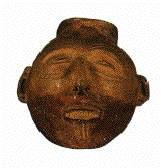 Cahokia
and the Mississippi Mound Builders
Cahokia
and the Mississippi Mound Builders
Mississippian Culture
 Cahokia
and the Mississippi Mound Builders
Cahokia
and the Mississippi Mound Builders
Table of Contents Bibliography Mound Sites
Introduction
The Mississippian Period of the
Eastern United States (approximately A.D. 1000 to 1600) was preceded by
the Late Woodland or Emergent Mississippian (A.D. 800 to 900/1000) period.
Geographically, Mississippian Societies were seen in a large portion of
the Mississippi drainage basin, as far north as Minnesota, as far west
as Texas, and as far south as the Florida panhandle. The focus of
much of the studies on the Mississippian period has been on an area known
as the American
Bottom, a section of the Mississippi River flood plain of fertile soil
ideal for agriculture that is near the confluence of the Missouri, Illinois,
and Missouri Rivers. The Mississippian Period is divided into Early (A.D.
1000 to 1200), Middle (A.D. 1200 to 1400) and Late (A.D. 1400 to 1500)
Periods. Europeans may have come in contact with some of the Late
Mississippian Societies, with the arrival Spanish explorers, such as Hernando
De Soto in Florida in 1539.
How Did Mississippian Societies
Emerge?
Mark Meher and James Collins stressed
that "there was no dramatic revolution or replacement of local populations
with outlanders at the onset of the Mississippian period. Indeed,
the transition from Emergent Mississippian to Mississippian is characterized
more by continuity than it is by contrast in terms of technology and art"
(Meher & Collins, 1995, pp. 54-55). Although this is an
idea shared by Raymond Fowler, who has done much research on the Mississippian
period, it is not shared by all. Donald Lathrap and his students
at the University of Illinois at Urbana-Champaign believe that there may
have been a migration of MesoAmericans and/or Caddonians.
This may have meant the migration of a fully developed Mississippian culture
to the American Bottom. A compromise theory has the development of
Mississippian Culture, with some migration from other areas affecting its
development. For example, James Porter has hypothesized that the
Emergent Mississippian society was made up of smaller farmsteads, which
may have had one or two smaller mounds at their center. A "true Mississippian
Culture" developed when an "intrusive merchant class" from the lower Mississippi
Valley took over the American Bottom. This intrusive merchant class
developed considerable control over these farmsteads, developing centralized
power, such as that seen in the urban centers of Cahokia
and
Moundville.
Structure of Society
Fowler hypothesized four
types of Mississippian community types (based on research specific
to Cahokia). James Porter has also developed a "chain settlement
model" that describes the composition, size and structure of various levels
of communities. These models have meaning because they guide research
that helps us to learn about how Mississippian Societies could differ in
the presence, number, and power of these varying types of communities and
how this was related to social differentiation and other aspects of how
they lived. This is an active area of research, with many unanswered
questions remaining.
Mississippian society differed in its hierarchical structure from prior populations, with people differentiated according to social, religions, economic, and occupational status. This hierarchical structure was typified by the existence of chiefdoms, which have been the focus of much study. A common thread of Mississippian culture is a reliance on agriculture, in particular - corn, as well as beans and squash. Larger population densities were seen in the urban center, which often had a mound at the center, where the chiefdom held its power. The mounds were not burial centers but, rather, ceremonial centers. The rich lands that the Mississippian Societies occupied (with dense, rich forests and fertile soil for agriculture) along with a developed trade network between Mississippian cities, villages, and farmsteads is thought to have been responsible for the amassing of wealth in the urban centers. The chiefdoms gained and maintained power by controlling this wealth. Although much of the research on the Mississippian Period has focused on the urban centers and on the structure of chiefdoms, it is believed that many people living in Mississippian Period lived in smaller communities, which were relatively self-sufficient and not heavily affected by chiefdoms. The point is, that while chiefdoms were an important development, there was believed to be wide variability in the extent to which specific Mississippian Societies were affected by them.
Palisades were built at some sites and during some periods to protect the ceremonial centers (mounds) from invaders - suggesting that warfare was a meaningful event in some Mississippian societies - perhaps as a way for chiefdoms to maintain power. Most of the urban centers (such as Cahokia, Moundville, and Etowah) have palisades, with the exception of Spiro - which for a yet unknown reason appears to have had no protective palisades.
Link
University
of Illinois RiverWeb - Mississippian Period
The RiverWeb site is an educational
and outreach site of the University of Illinois at Urbana-Champaign.
This section of the site focuses on the environment, society, technology,
economy and art of Mississippian culture.
National
Parks Service Mississippian Period
This National Parks Service Site
give an excellent presentation on the Mississippian Period, with links
to dozens of Mississippian period sites.
One
Page Summary of Mississippian Period
This site gives a one page overview
of the Mississippian Period.